Attached files
| file | filename |
|---|---|
| 8-K - FORM 8-K - Eledon Pharmaceuticals, Inc. | d109299d8k.htm |
| EX-99.2 - EX-99.2 - Eledon Pharmaceuticals, Inc. | d109299dex992.htm |
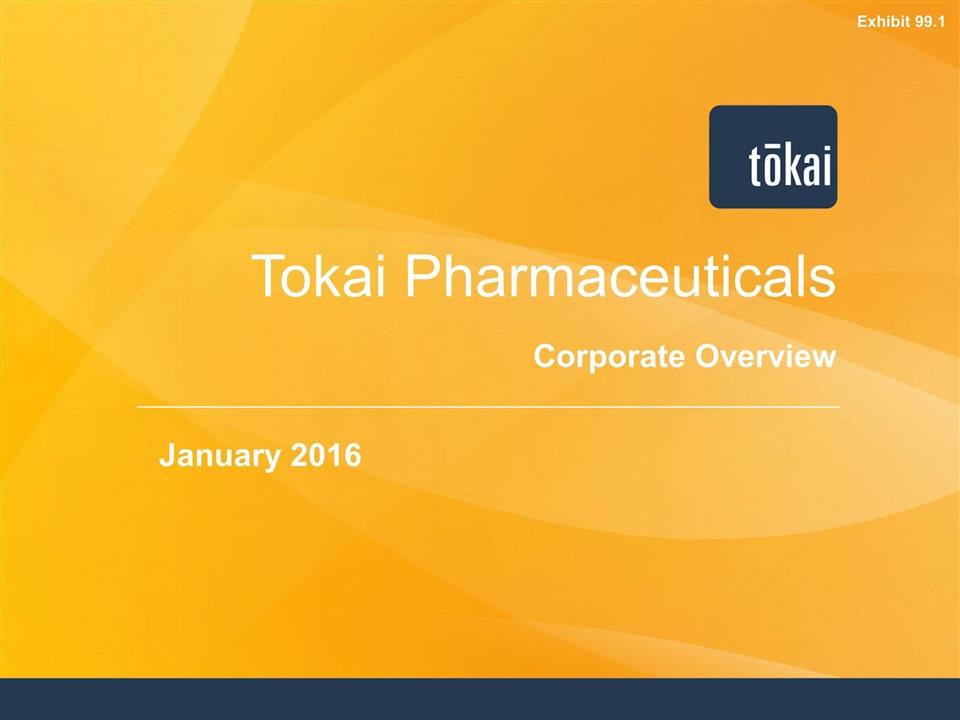
Tokai Pharmaceuticals Corporate Overview January 2016 Exhibit 99.1
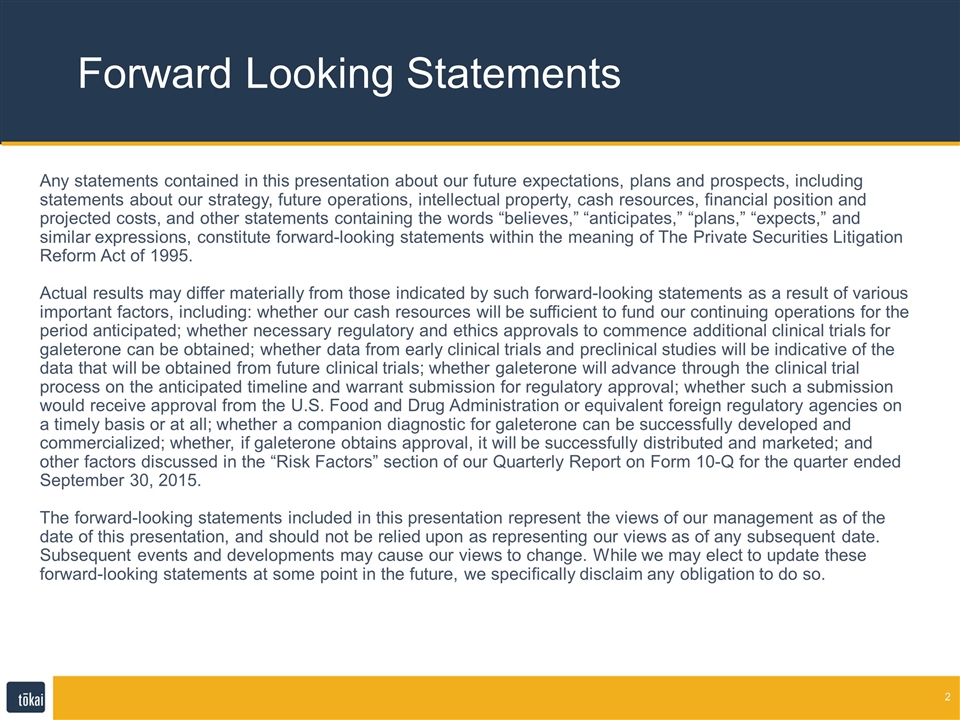
Any statements contained in this presentation about our future expectations, plans and prospects, including statements about our strategy, future operations, intellectual property, cash resources, financial position and projected costs, and other statements containing the words “believes,” “anticipates,” “plans,” “expects,” and similar expressions, constitute forward-looking statements within the meaning of The Private Securities Litigation Reform Act of 1995. Actual results may differ materially from those indicated by such forward-looking statements as a result of various important factors, including: whether our cash resources will be sufficient to fund our continuing operations for the period anticipated; whether necessary regulatory and ethics approvals to commence additional clinical trials for galeterone can be obtained; whether data from early clinical trials and preclinical studies will be indicative of the data that will be obtained from future clinical trials; whether galeterone will advance through the clinical trial process on the anticipated timeline and warrant submission for regulatory approval; whether such a submission would receive approval from the U.S. Food and Drug Administration or equivalent foreign regulatory agencies on a timely basis or at all; whether a companion diagnostic for galeterone can be successfully developed and commercialized; whether, if galeterone obtains approval, it will be successfully distributed and marketed; and other factors discussed in the “Risk Factors” section of our Quarterly Report on Form 10-Q for the quarter ended September 30, 2015. The forward-looking statements included in this presentation represent the views of our management as of the date of this presentation, and should not be relied upon as representing our views as of any subsequent date. Subsequent events and developments may cause our views to change. While we may elect to update these forward-looking statements at some point in the future, we specifically disclaim any obligation to do so. Forward Looking Statements
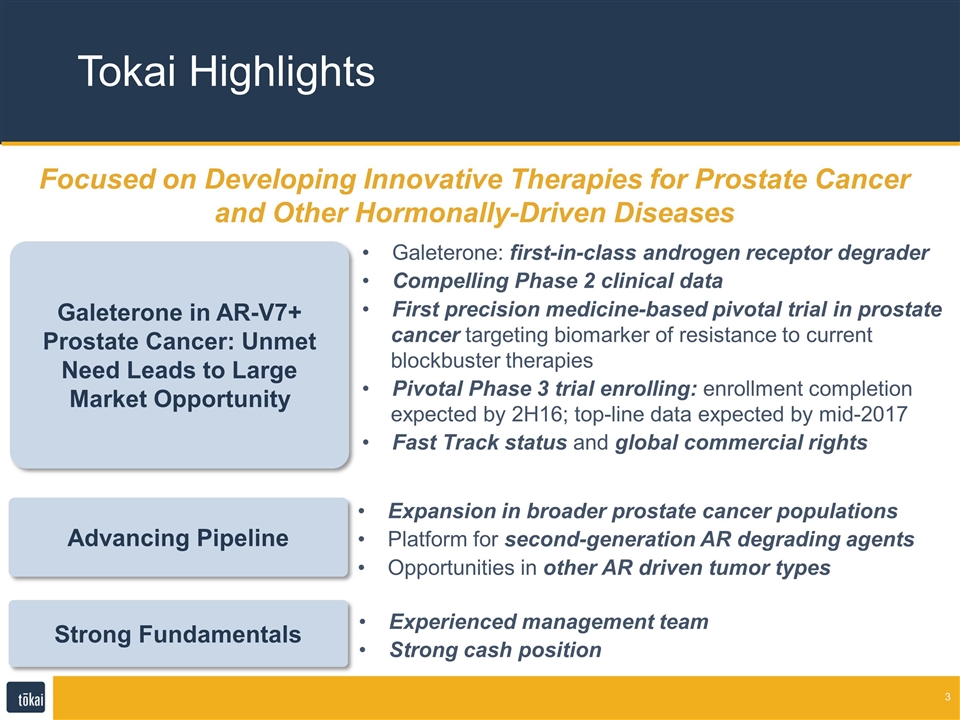
Tokai Highlights Focused on Developing Innovative Therapies for Prostate Cancer and Other Hormonally-Driven Diseases Galeterone in AR-V7+ Prostate Cancer: Unmet Need Leads to Large Market Opportunity Advancing Pipeline Strong Fundamentals Galeterone: first-in-class androgen receptor degrader Compelling Phase 2 clinical data First precision medicine-based pivotal trial in prostate cancer targeting biomarker of resistance to current blockbuster therapies Pivotal Phase 3 trial enrolling: enrollment completion expected by 2H16; top-line data expected by mid-2017 Fast Track status and global commercial rights Expansion in broader prostate cancer populations Platform for second-generation AR degrading agents Opportunities in other AR driven tumor types Experienced management team Strong cash position
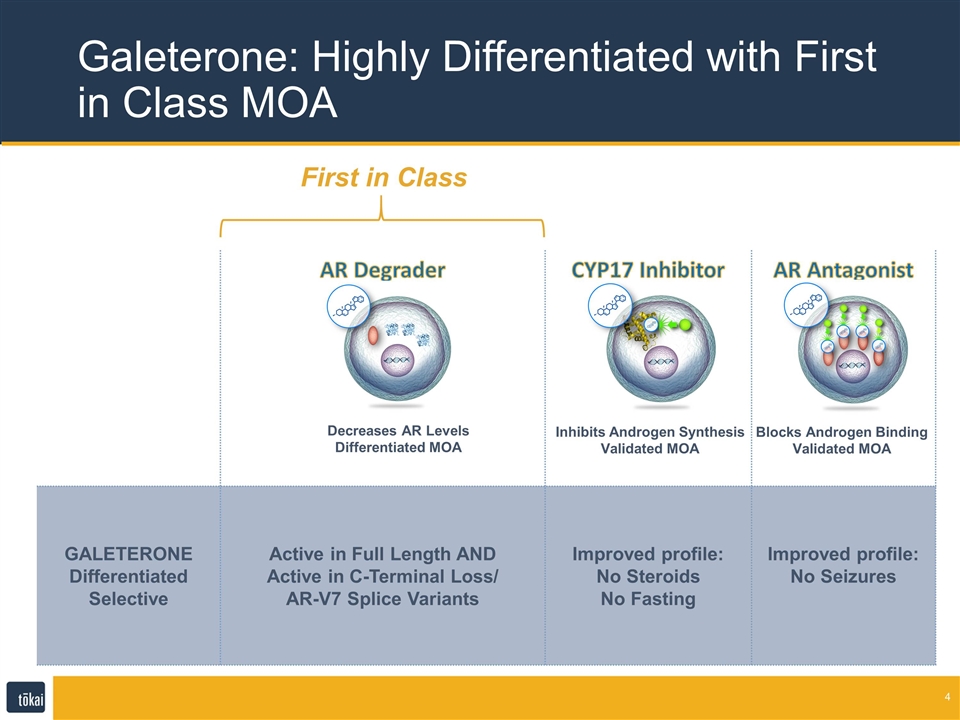
Galeterone: Highly Differentiated with First in Class MOA First in Class AR Degrader CYP17 Inhibitor AR Antagonist GALETERONE Differentiated Selective Active in Full Length AND Active in C-Terminal Loss/ AR-V7 Splice Variants Improved profile: No Steroids No Fasting Improved profile: No Seizures Decreases AR Levels Differentiated MOA Inhibits Androgen Synthesis Validated MOA Blocks Androgen Binding Validated MOA
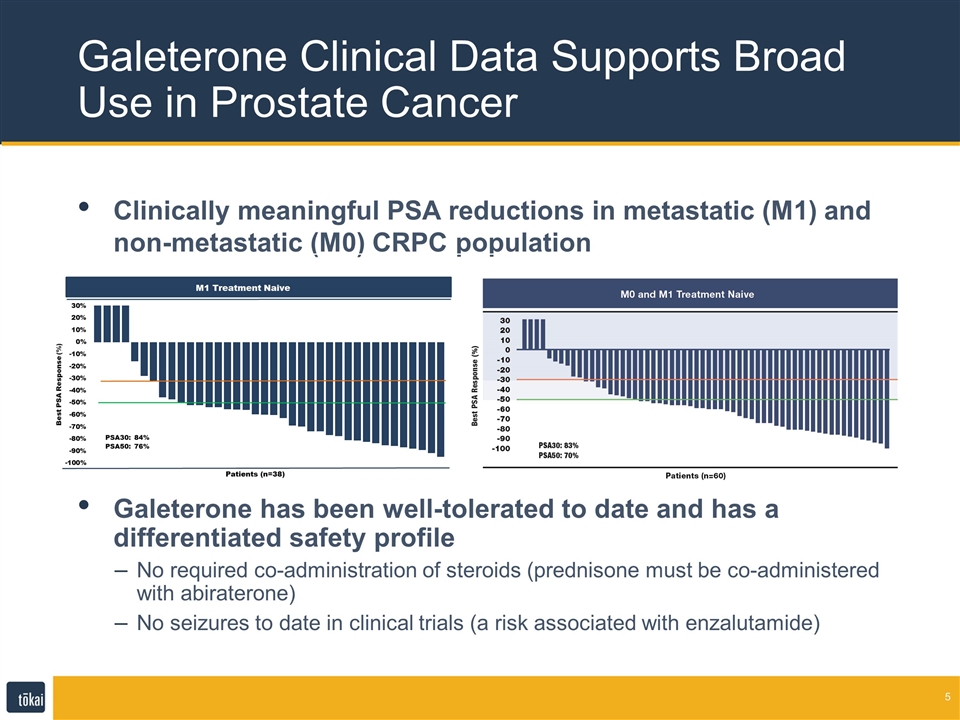
Clinically meaningful PSA reductions in metastatic (M1) and non-metastatic (M0) CRPC population Galeterone has been well-tolerated to date and has a differentiated safety profile No required co-administration of steroids (prednisone must be co-administered with abiraterone) No seizures to date in clinical trials (a risk associated with enzalutamide) Galeterone Clinical Data Supports Broad Use in Prostate Cancer
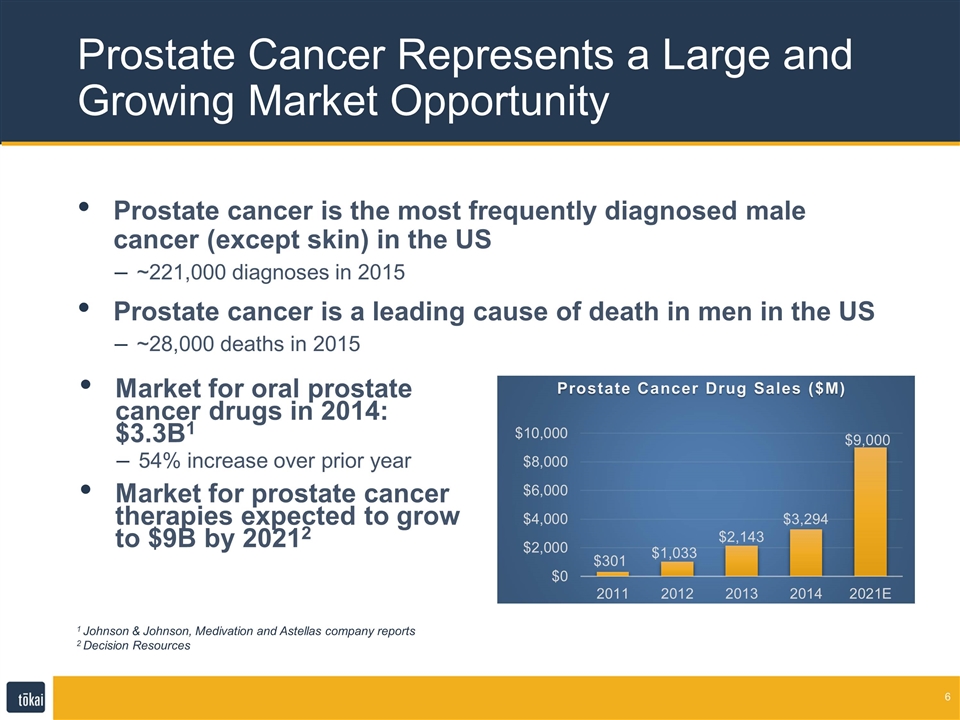
Prostate cancer is the most frequently diagnosed male cancer (except skin) in the US ~221,000 diagnoses in 2015 Prostate cancer is a leading cause of death in men in the US ~28,000 deaths in 2015 Prostate Cancer Represents a Large and Growing Market Opportunity Market for oral prostate cancer drugs in 2014: $3.3B1 54% increase over prior year Market for prostate cancer therapies expected to grow to $9B by 20212 1 Johnson & Johnson, Medivation and Astellas company reports 2 Decision Resources
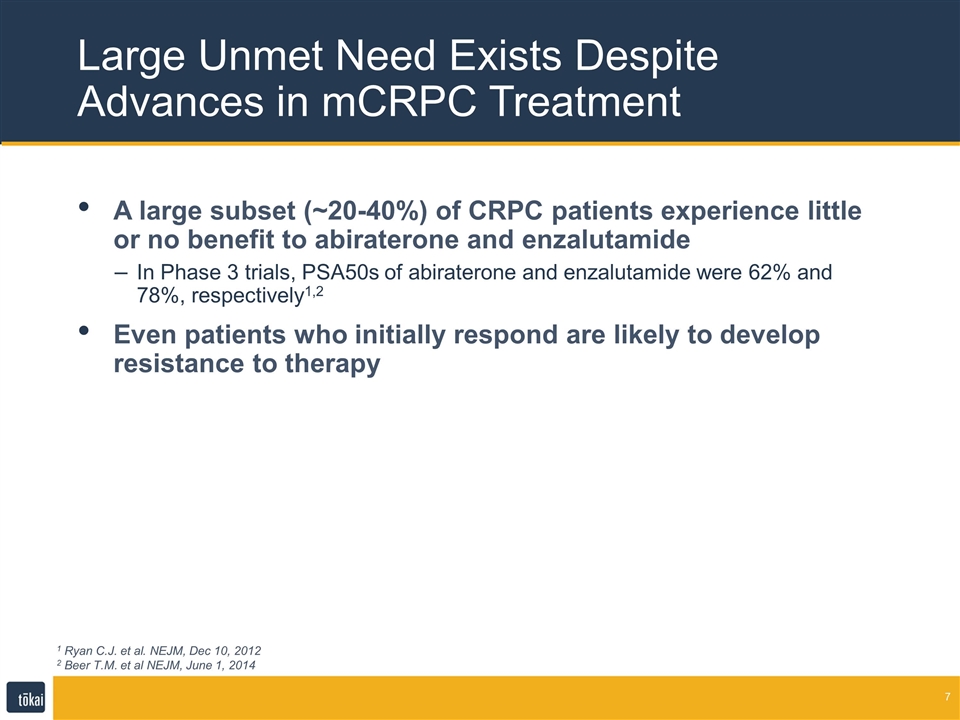
A large subset (~20-40%) of CRPC patients experience little or no benefit to abiraterone and enzalutamide In Phase 3 trials, PSA50s of abiraterone and enzalutamide were 62% and 78%, respectively1,2 Even patients who initially respond are likely to develop resistance to therapy Large Unmet Need Exists Despite Advances in mCRPC Treatment 1 Ryan C.J. et al. NEJM, Dec 10, 2012 2 Beer T.M. et al NEJM, June 1, 2014
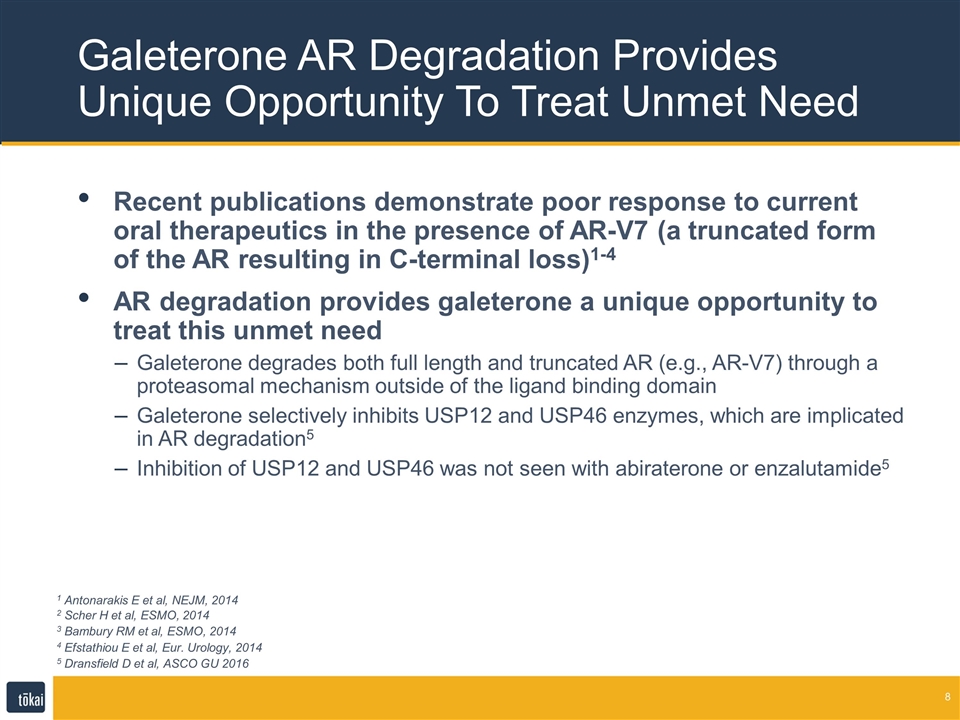
Recent publications demonstrate poor response to current oral therapeutics in the presence of AR-V7 (a truncated form of the AR resulting in C-terminal loss)1-4 AR degradation provides galeterone a unique opportunity to treat this unmet need Galeterone degrades both full length and truncated AR (e.g., AR-V7) through a proteasomal mechanism outside of the ligand binding domain Galeterone selectively inhibits USP12 and USP46 enzymes, which are implicated in AR degradation5 Inhibition of USP12 and USP46 was not seen with abiraterone or enzalutamide5 Galeterone AR Degradation Provides Unique Opportunity To Treat Unmet Need 1 Antonarakis E et al, NEJM, 2014 2 Scher H et al, ESMO, 2014 3 Bambury RM et al, ESMO, 2014 4 Efstathiou E et al, Eur. Urology, 2014 5 Dransfield D et al, ASCO GU 2016
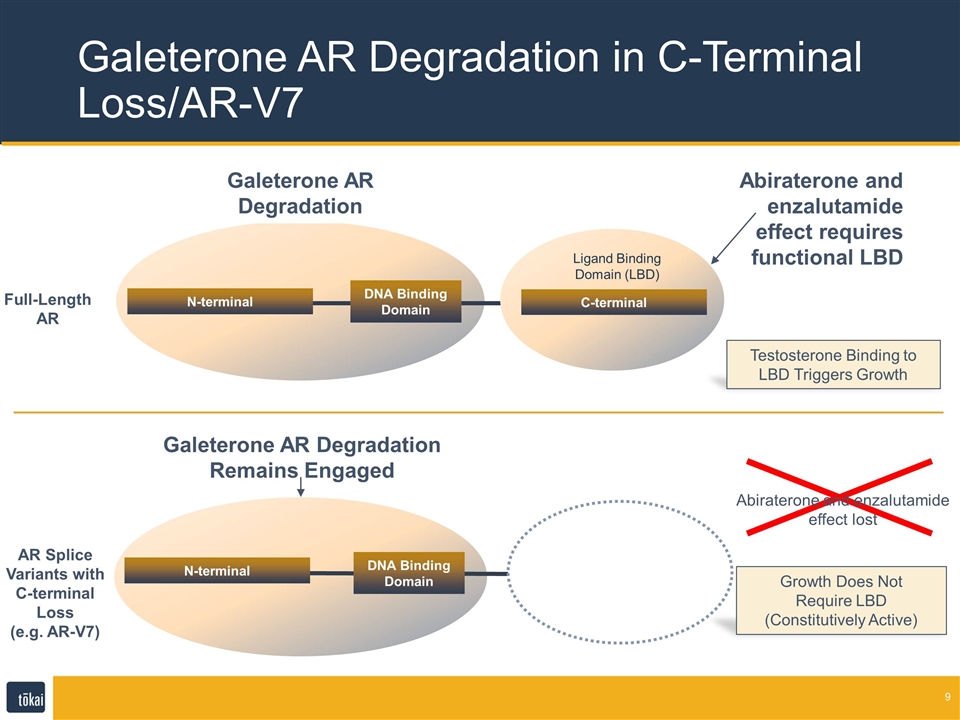
Galeterone AR Degradation in C-Terminal Loss/AR-V7 Galeterone AR Degradation DNA Binding Domain Full-Length AR Testosterone Binding to LBD Triggers Growth N-terminal Ligand Binding Domain (LBD) C-terminal Abiraterone and enzalutamide effect requires functional LBD Galeterone AR Degradation Remains Engaged DNA Binding Domain N-terminal Growth Does Not Require LBD (Constitutively Active) AR Splice Variants with C-terminal Loss (e.g. AR-V7) Abiraterone and enzalutamide effect lost
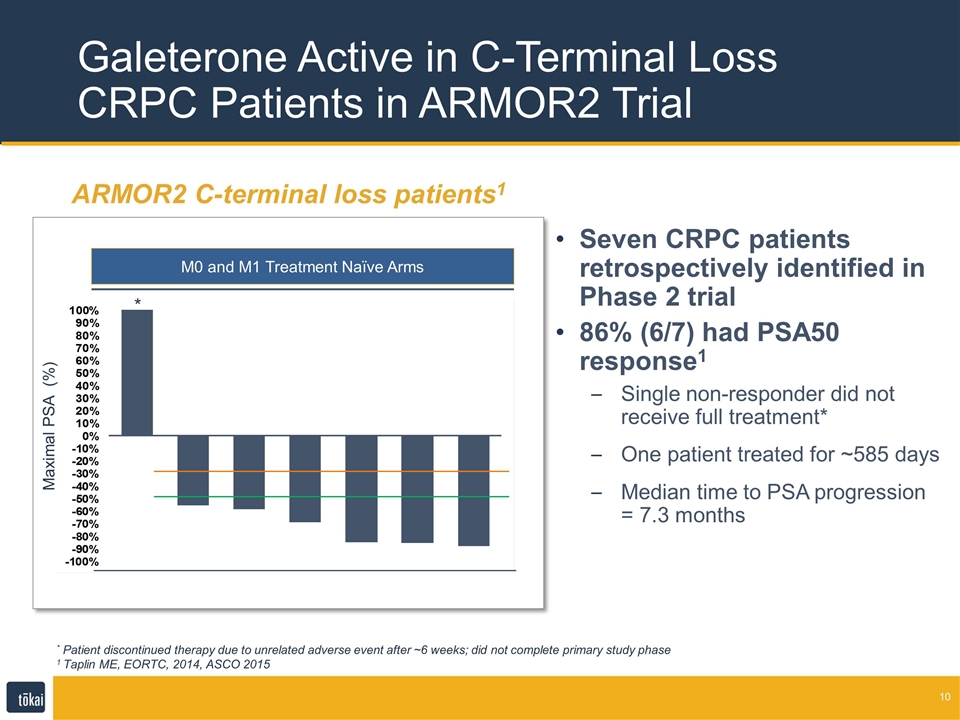
Galeterone Active in C-Terminal Loss CRPC Patients in ARMOR2 Trial ARMOR2 C-terminal loss patients1 Maximal PSA (%) M0 and M1 Treatment Naïve Arms * Seven CRPC patients retrospectively identified in Phase 2 trial 86% (6/7) had PSA50 response1 Single non-responder did not receive full treatment* One patient treated for ~585 days Median time to PSA progression = 7.3 months * Patient discontinued therapy due to unrelated adverse event after ~6 weeks; did not complete primary study phase 1 Taplin ME, EORTC, 2014, ASCO 2015
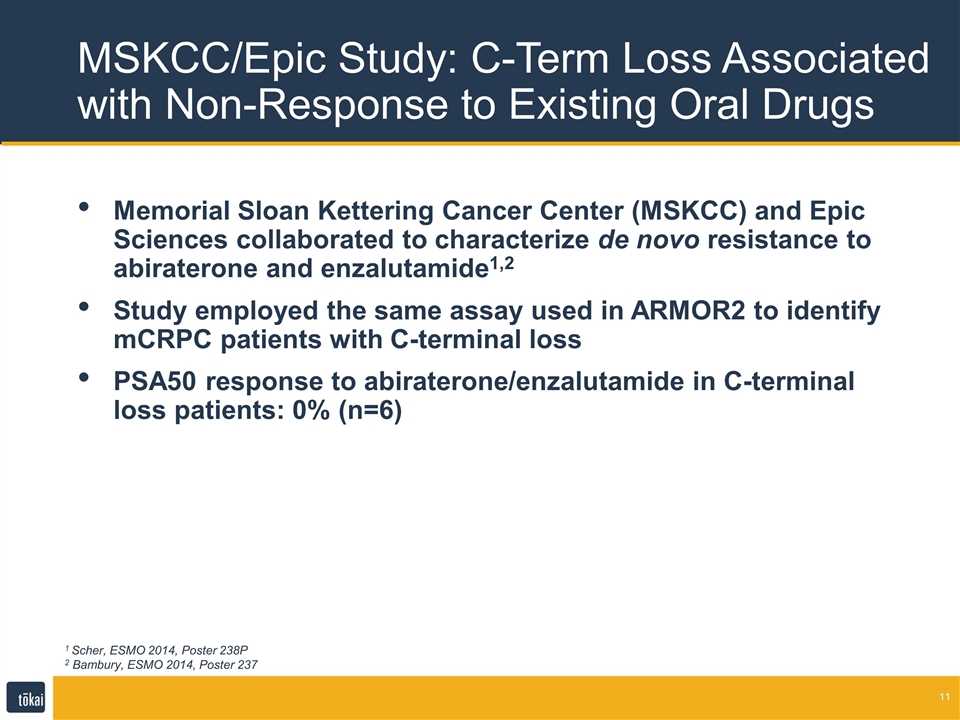
Memorial Sloan Kettering Cancer Center (MSKCC) and Epic Sciences collaborated to characterize de novo resistance to abiraterone and enzalutamide1,2 Study employed the same assay used in ARMOR2 to identify mCRPC patients with C-terminal loss PSA50 response to abiraterone/enzalutamide in C-terminal loss patients: 0% (n=6) MSKCC/Epic Study: C-Term Loss Associated with Non-Response to Existing Oral Drugs 1 Scher, ESMO 2014, Poster 238P 2 Bambury, ESMO 2014, Poster 237
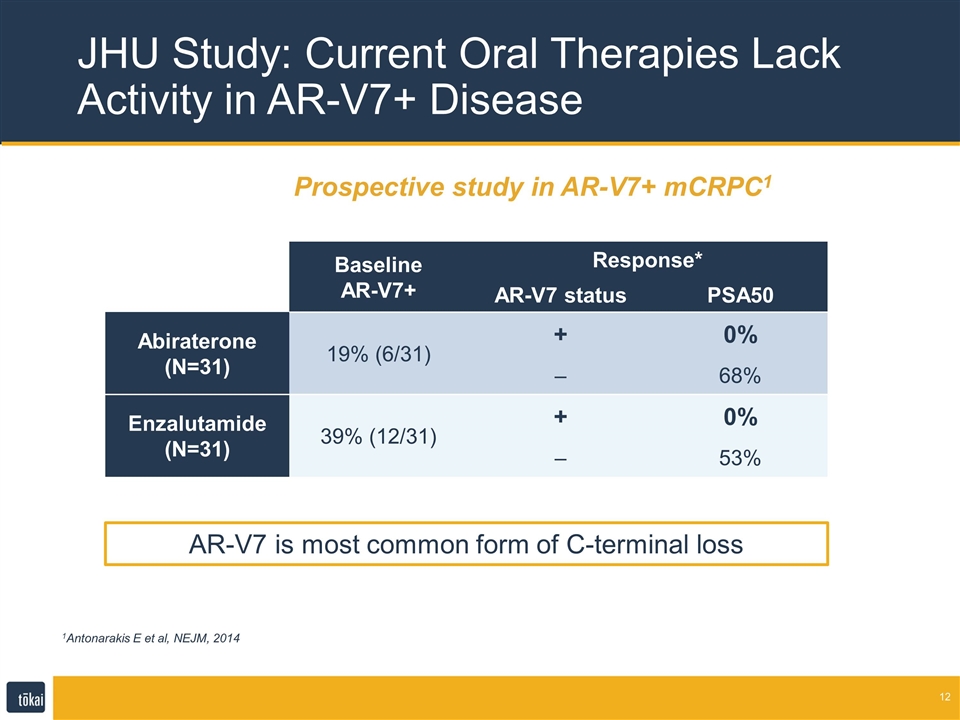
JHU Study: Current Oral Therapies Lack Activity in AR-V7+ Disease Prospective study in AR-V7+ mCRPC1 Baseline AR-V7+ Response* AR-V7 status PSA50 Abiraterone (N=31) 19% (6/31) + 0% – 68% Enzalutamide (N=31) 39% (12/31) + 0% – 53% 1Antonarakis E et al, NEJM, 2014 AR-V7 is most common form of C-terminal loss
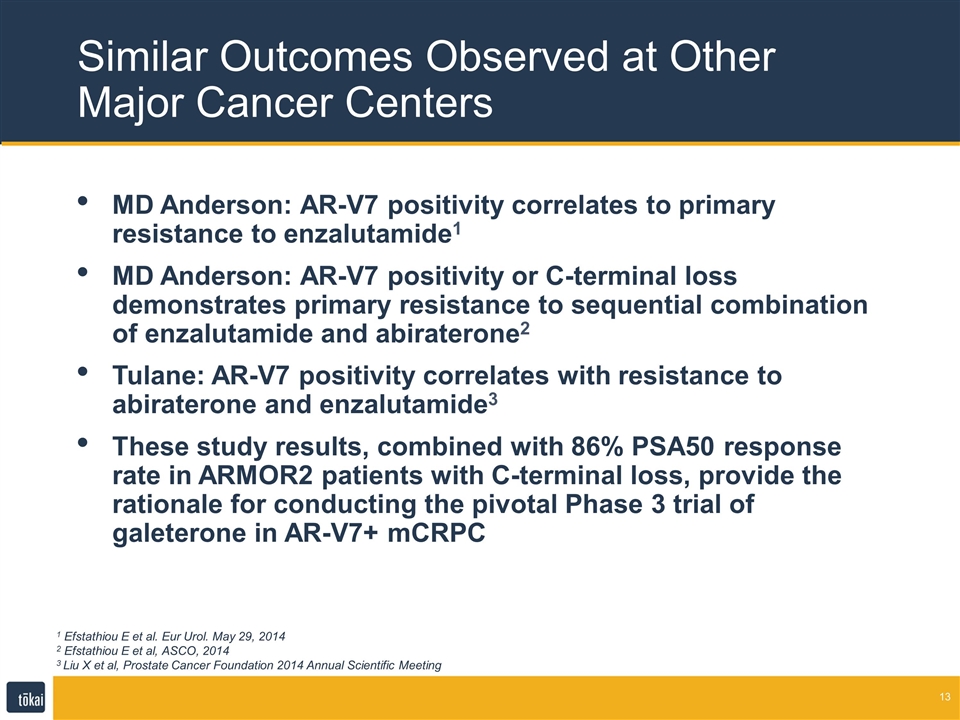
MD Anderson: AR-V7 positivity correlates to primary resistance to enzalutamide1 MD Anderson: AR-V7 positivity or C-terminal loss demonstrates primary resistance to sequential combination of enzalutamide and abiraterone2 Tulane: AR-V7 positivity correlates with resistance to abiraterone and enzalutamide3 These study results, combined with 86% PSA50 response rate in ARMOR2 patients with C-terminal loss, provide the rationale for conducting the pivotal Phase 3 trial of galeterone in AR-V7+ mCRPC Similar Outcomes Observed at Other Major Cancer Centers 1 Efstathiou E et al. Eur Urol. May 29, 2014 2 Efstathiou E et al, ASCO, 2014 3 Liu X et al, Prostate Cancer Foundation 2014 Annual Scientific Meeting
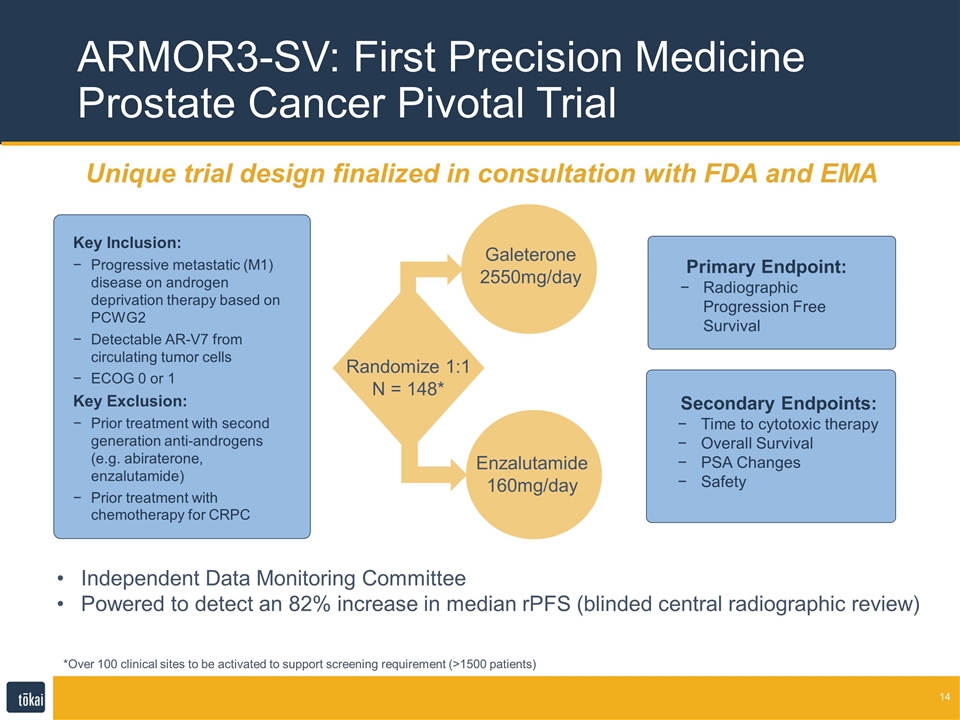
ARMOR3-SV: First Precision Medicine Prostate Cancer Pivotal Trial Unique trial design finalized in consultation with FDA and EMA Independent Data Monitoring Committee Powered to detect an 82% increase in median rPFS (blinded central radiographic review) Galeterone 2550mg/day Randomize 1:1 N = 148* Primary Endpoint: Radiographic Progression Free Survival Enzalutamide 160mg/day Secondary Endpoints: Time to cytotoxic therapy Overall Survival PSA Changes Safety Key Inclusion: Progressive metastatic (M1) disease on androgen deprivation therapy based on PCWG2 Detectable AR-V7 from circulating tumor cells ECOG 0 or 1 Key Exclusion: Prior treatment with second generation anti-androgens (e.g. abiraterone, enzalutamide) Prior treatment with chemotherapy for CRPC *Over 100 clinical sites to be activated to support screening requirement (>1500 patients)
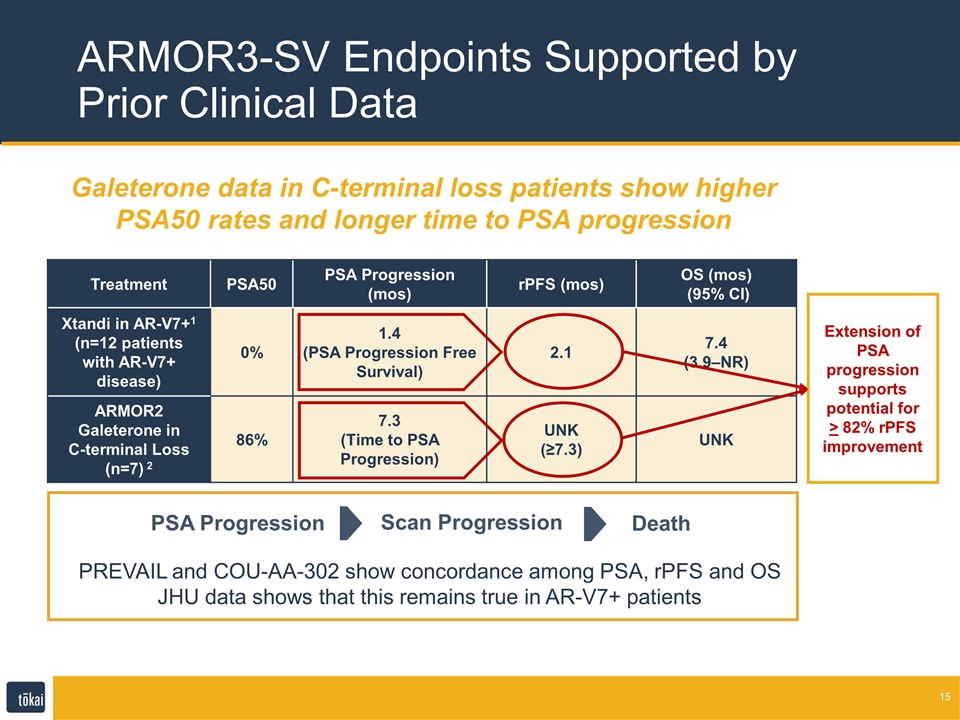
ARMOR3-SV Endpoints Supported by Prior Clinical Data Galeterone data in C-terminal loss patients show higher PSA50 rates and longer time to PSA progression Death Scan Progression PSA Progression PREVAIL and COU-AA-302 show concordance among PSA, rPFS and OS JHU data shows that this remains true in AR-V7+ patients Treatment PSA50 PSA Progression (mos) rPFS (mos) OS (mos) (95% CI) Xtandi in AR-V7+1 (n=12 patients with AR-V7+ disease) 0% 1.4 (PSA Progression Free Survival) 2.1 7.4 (3.9–NR) ARMOR2 Galeterone in C-terminal Loss (n=7) 2 86% 7.3 (Time to PSA Progression) UNK (≥7.3) UNK Extension of PSA progression supports potential for > 82% rPFS improvement
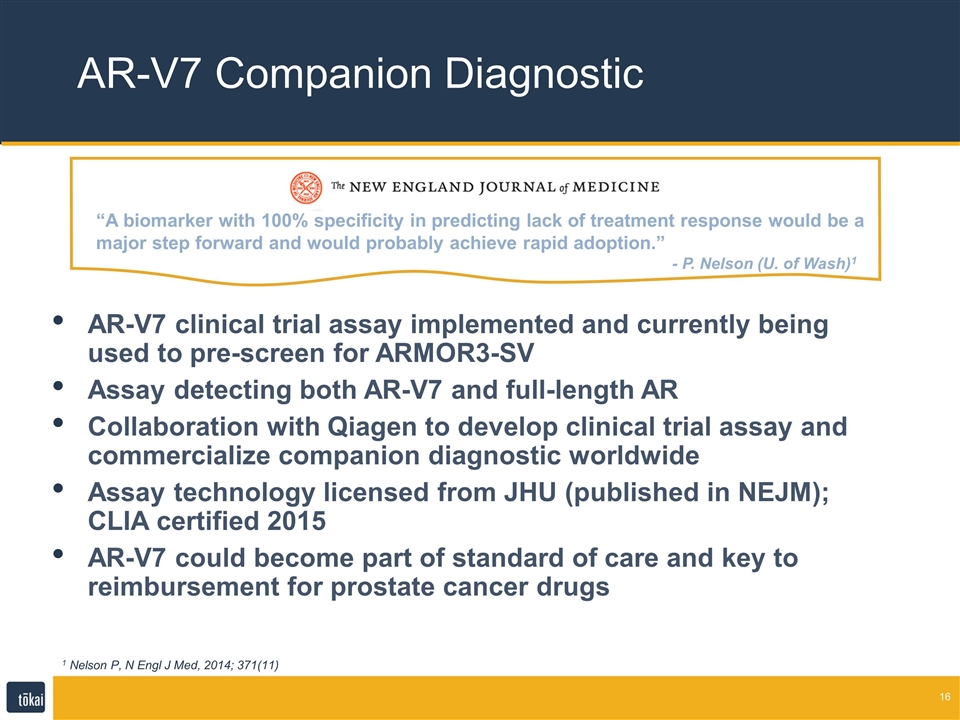
AR-V7 clinical trial assay implemented and currently being used to pre-screen for ARMOR3-SV Assay detecting both AR-V7 and full-length AR Collaboration with Qiagen to develop clinical trial assay and commercialize companion diagnostic worldwide Assay technology licensed from JHU (published in NEJM); CLIA certified 2015 AR-V7 could become part of standard of care and key to reimbursement for prostate cancer drugs AR-V7 Companion Diagnostic “A biomarker with 100% specificity in predicting lack of treatment response would be a major step forward and would probably achieve rapid adoption.” - P. Nelson (U. of Wash)1 1 Nelson P, N Engl J Med, 2014; 371(11)
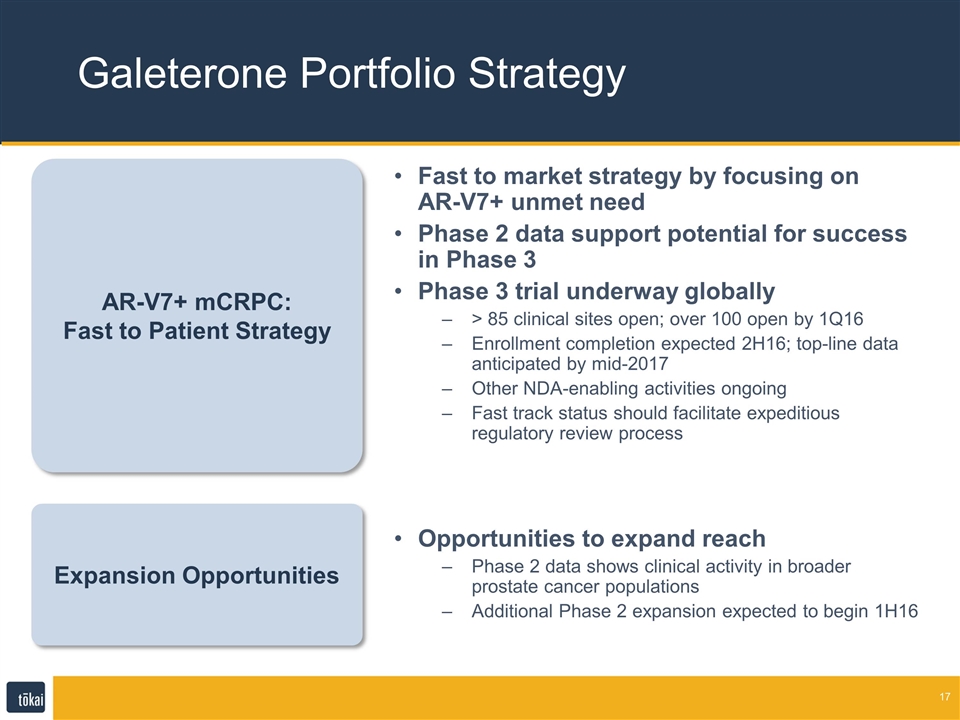
Secondary Endpoints: Time to cytotoxic therapy Overall Survival (OS) PSA Changes Safety Galeterone Portfolio Strategy Fast to market strategy by focusing on AR-V7+ unmet need Phase 2 data support potential for success in Phase 3 Phase 3 trial underway globally > 85 clinical sites open; over 100 open by 1Q16 Enrollment completion expected 2H16; top-line data anticipated by mid-2017 Other NDA-enabling activities ongoing Fast track status should facilitate expeditious regulatory review process Opportunities to expand reach Phase 2 data shows clinical activity in broader prostate cancer populations Additional Phase 2 expansion expected to begin 1H16 AR-V7+ mCRPC: Fast to Patient Strategy Expansion Opportunities
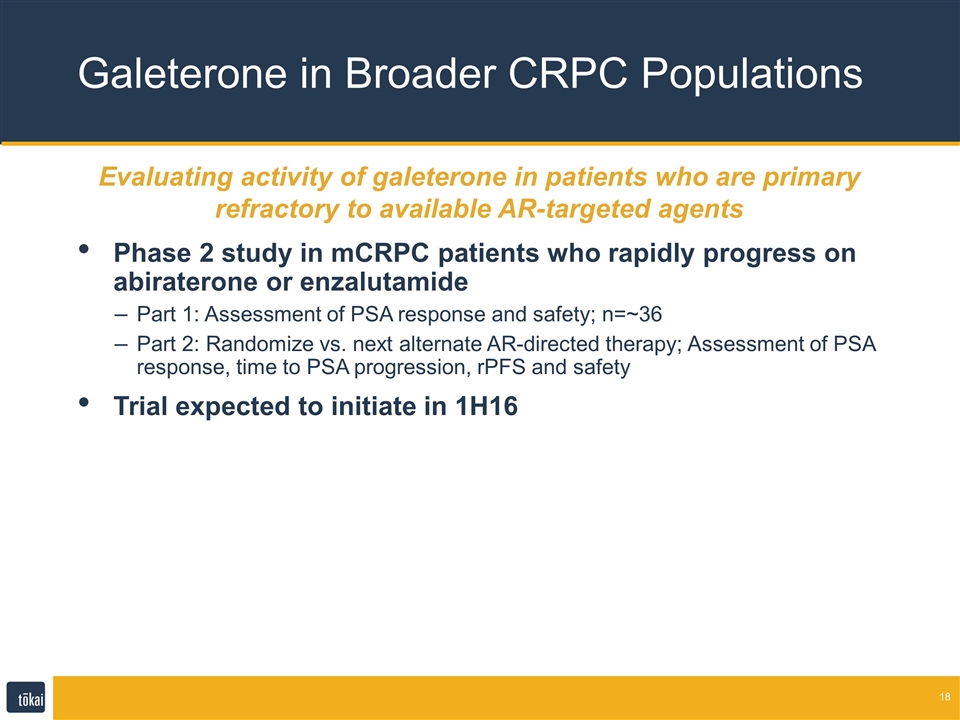
Phase 2 study in mCRPC patients who rapidly progress on abiraterone or enzalutamide Part 1: Assessment of PSA response and safety; n=~36 Part 2: Randomize vs. next alternate AR-directed therapy; Assessment of PSA response, time to PSA progression, rPFS and safety Trial expected to initiate in 1H16 Galeterone in Broader CRPC Populations Evaluating activity of galeterone in patients who are primary refractory to available AR-targeted agents
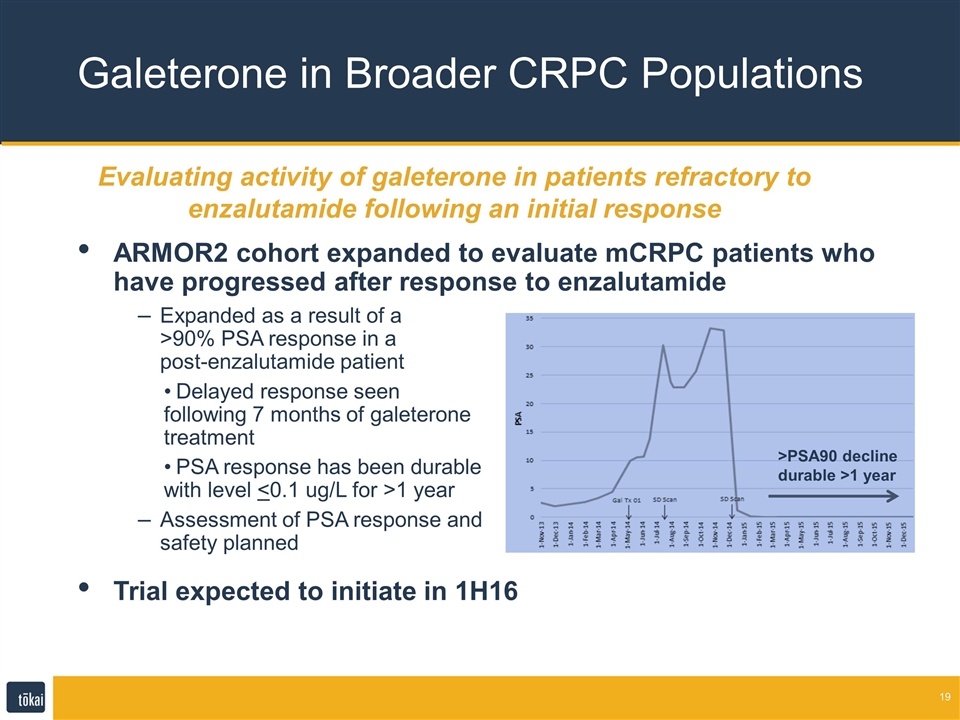
ARMOR2 cohort expanded to evaluate mCRPC patients who have progressed after response to enzalutamide Trial expected to initiate in 1H16 Galeterone in Broader CRPC Populations Evaluating activity of galeterone in patients refractory to enzalutamide following an initial response Expanded as a result of a >90% PSA response in a post-enzalutamide patient Delayed response seen following 7 months of galeterone treatment PSA response has been durable with level <0.1 ug/L for >1 year Assessment of PSA response and safety planned >PSA90 decline durable >1 year
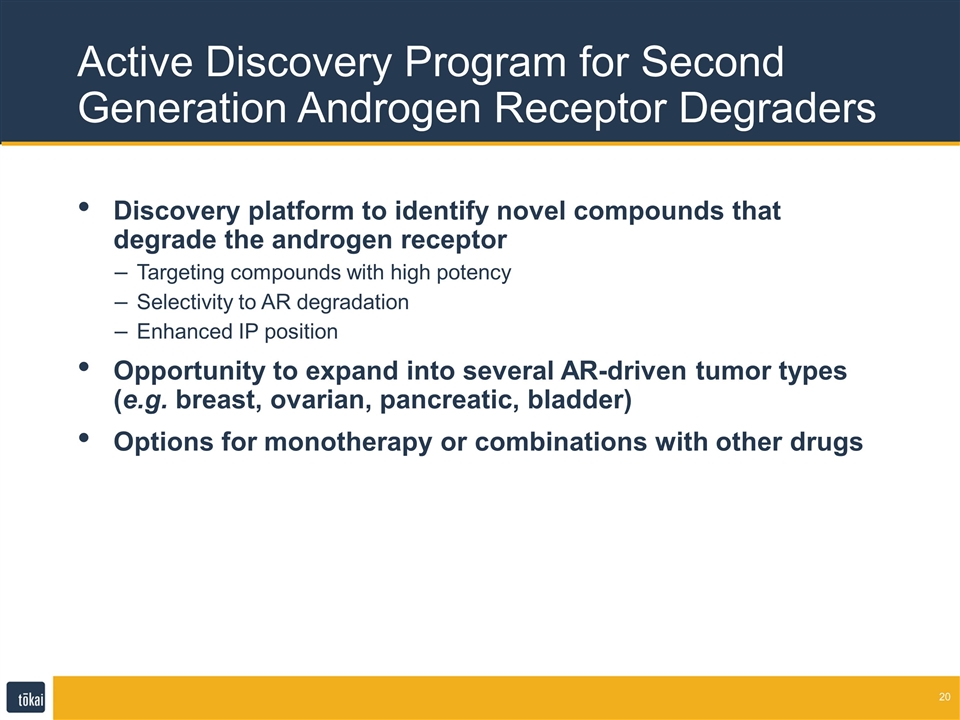
Discovery platform to identify novel compounds that degrade the androgen receptor Targeting compounds with high potency Selectivity to AR degradation Enhanced IP position Opportunity to expand into several AR-driven tumor types (e.g. breast, ovarian, pancreatic, bladder) Options for monotherapy or combinations with other drugs Active Discovery Program for Second Generation Androgen Receptor Degraders
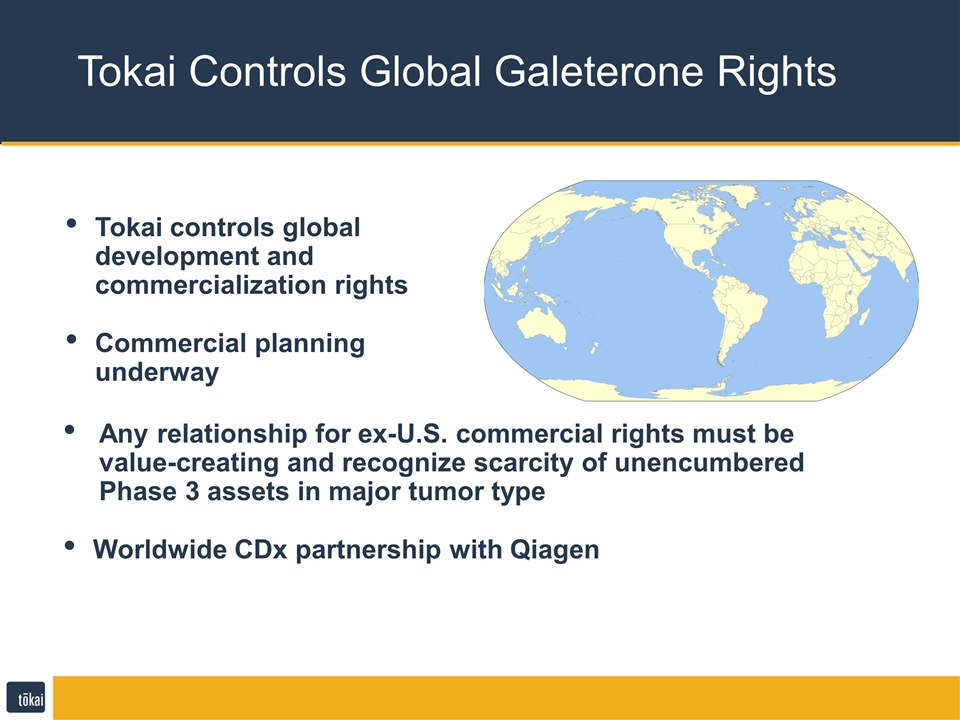
Tokai Controls Global Galeterone Rights Tokai controls global development and commercialization rights Commercial planning underway Any relationship for ex-U.S. commercial rights must be value-creating and recognize scarcity of unencumbered Phase 3 assets in major tumor type Worldwide CDx partnership with Qiagen
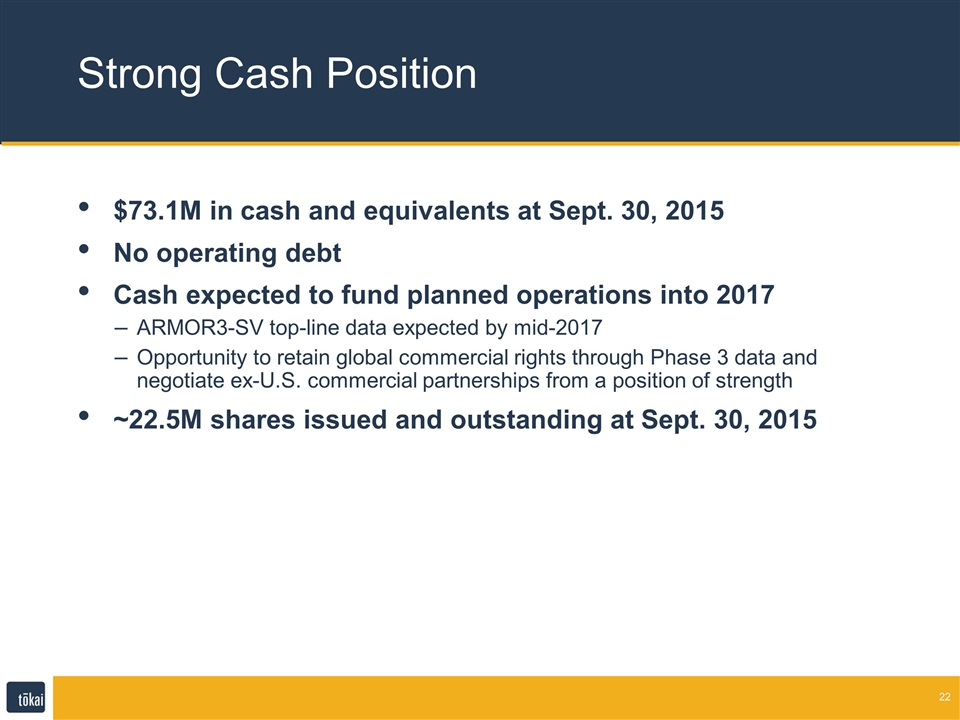
$73.1M in cash and equivalents at Sept. 30, 2015 No operating debt Cash expected to fund planned operations into 2017 ARMOR3-SV top-line data expected by mid-2017 Opportunity to retain global commercial rights through Phase 3 data and negotiate ex-U.S. commercial partnerships from a position of strength ~22.5M shares issued and outstanding at Sept. 30, 2015 Strong Cash Position
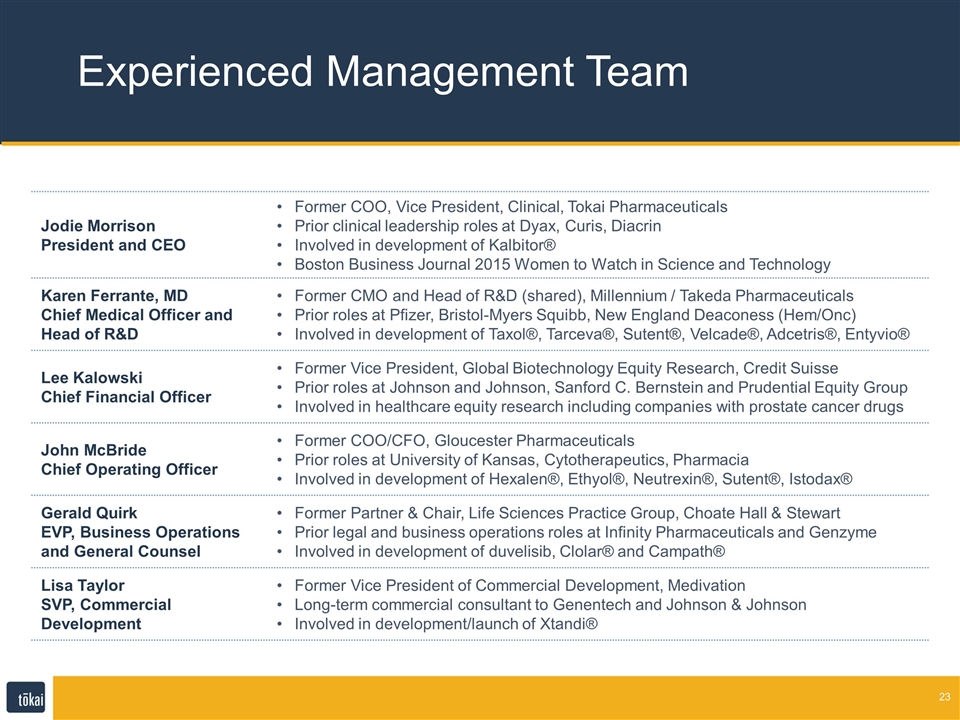
Experienced Management Team Jodie Morrison President and CEO Former COO, Vice President, Clinical, Tokai Pharmaceuticals Prior clinical leadership roles at Dyax, Curis, Diacrin Involved in development of Kalbitor® Boston Business Journal 2015 Women to Watch in Science and Technology Karen Ferrante, MD Chief Medical Officer and Head of R&D Former CMO and Head of R&D (shared), Millennium / Takeda Pharmaceuticals Prior roles at Pfizer, Bristol-Myers Squibb, New England Deaconess (Hem/Onc) Involved in development of Taxol®, Tarceva®, Sutent®, Velcade®, Adcetris®, Entyvio® Lee Kalowski Chief Financial Officer Former Vice President, Global Biotechnology Equity Research, Credit Suisse Prior roles at Johnson and Johnson, Sanford C. Bernstein and Prudential Equity Group Involved in healthcare equity research including companies with prostate cancer drugs John McBride Chief Operating Officer Former COO/CFO, Gloucester Pharmaceuticals Prior roles at University of Kansas, Cytotherapeutics, Pharmacia Involved in development of Hexalen®, Ethyol®, Neutrexin®, Sutent®, Istodax® Gerald Quirk EVP, Business Operations and General Counsel Former Partner & Chair, Life Sciences Practice Group, Choate Hall & Stewart Prior legal and business operations roles at Infinity Pharmaceuticals and Genzyme Involved in development of duvelisib, Clolar® and Campath® Lisa Taylor SVP, Commercial Development Former Vice President of Commercial Development, Medivation Long-term commercial consultant to Genentech and Johnson & Johnson Involved in development/launch of Xtandi®
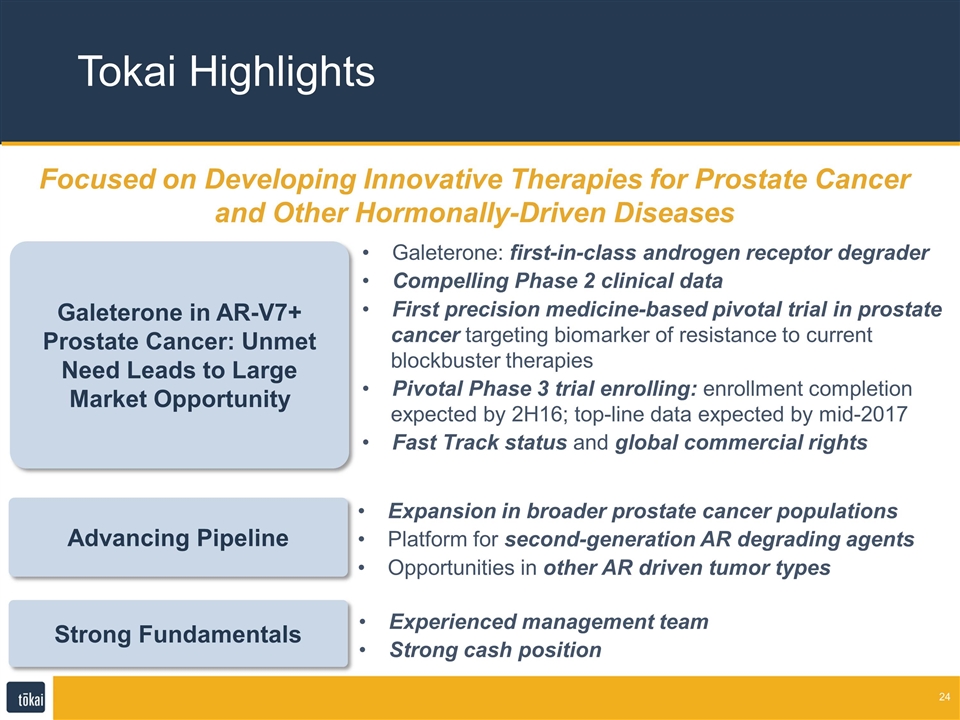
Tokai Highlights Focused on Developing Innovative Therapies for Prostate Cancer and Other Hormonally-Driven Diseases Galeterone in AR-V7+ Prostate Cancer: Unmet Need Leads to Large Market Opportunity Advancing Pipeline Strong Fundamentals Galeterone: first-in-class androgen receptor degrader Compelling Phase 2 clinical data First precision medicine-based pivotal trial in prostate cancer targeting biomarker of resistance to current blockbuster therapies Pivotal Phase 3 trial enrolling: enrollment completion expected by 2H16; top-line data expected by mid-2017 Fast Track status and global commercial rights Expansion in broader prostate cancer populations Platform for second-generation AR degrading agents Opportunities in other AR driven tumor types Experienced management team Strong cash position
